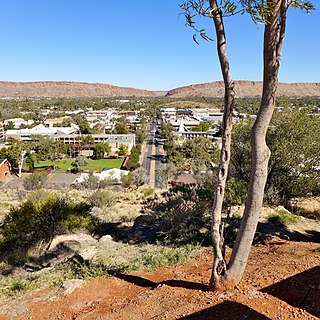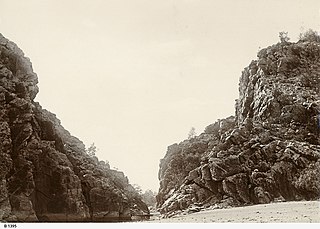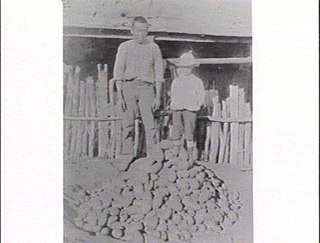Related Research Articles

Alice Springs, is the third-largest town in the Northern Territory, Australia. The name Alice Springs was given by surveyor William Whitfield Mills after Alice, Lady Todd, wife of the telegraph pioneer Sir Charles Todd. Known colloquially as 'The Alice' or simply 'Alice', the town is situated roughly in Australia's geographic centre. It is nearly equidistant from Adelaide and Darwin.

Hermannsburg, also known as Ntaria, is an Aboriginal community in Ljirapinta Ward of the MacDonnell Shire in the Northern Territory of Australia, 125 kilometres (78 mi); west southwest of Alice Springs, on the Finke River, in the traditional lands of the Western Arrarnta people.

Wenten Rubuntja was an Australian artist, Aboriginal rights activist, and historian.
Yuendumu is a town in the Northern Territory of Australia, 293 km (182 mi) northwest of Alice Springs on the Tanami Road, within the Central Desert Region local government area. It ranks as one of the larger remote communities in central Australia, and has a thriving community of Aboriginal artists. It is home to Pintubi Anmatjere Warlpiri (PAW) Media, which produced the TV series Bush Mechanics.
Ltyentye Apurte, also known as Santa Teresa, is a small city in the Northern Territory, Australia, many residents of the city are members of the Arrernte indigenous community, whose origins are located about 80 kilometres (50 mi) south-east of Alice Springs.

Areyonga is a small town in the Northern Territory of Australia, located about 220 km (140 mi) west of Alice Springs. As of 2016 it had a population of about 195, most of whom are Aboriginal people of the Pitjantjatjara language group.

Arltunga is a deserted gold rush town located in the Northern Territory of Australia in the locality of Hart about 110 kilometres (68 mi) east of Alice Springs. It is of major historical significance as the first major European settlement in Central Australia.
Percy McDonald Smith (1903-1982) was the first Priest-in-Charge of Alice Springs for the Anglican Church. He was also the first Archdeacon of the Northern Territory, Australia, founder of St John's Hostel in Alice Springs and later the founder of St Francis House in the Adelaide suburb of Semaphore South at Glanville Hall.

Emily Gap / Anthwerrke is a natural attraction and significant cultural site in the East MacDonnell Ranges, eight kilometres to the east of Mparntwe/Alice Springs, in Australia's Northern Territory.
William Hurle Liddle was a pastoralist who established Angas Downs Station, in Central Australia, taking up the first pastoral lease in 1929.
Margaret Kemarre Turner, also known as M. K. Turner, was an Arrernte woman, who belonged to the Akarre people. Turner was an elder in her community, an interpreter, artist and author. She was also involved with the Institute for Aboriginal Development in Alice Springs where she taught language, culture and cross-cultural courses.
Alice Springs town camps, officially called Alice Springs Community Living Areas, are Aboriginal communities within Alice Springs in the Northern Territory of Australia. Their origins vary. Many were originally designed to accommodate people visiting Alice Springs from remote communities but, for many, they have become a permanent and often generational home.
Griffiths House was a Methodist children's home and hostel that operated in Alice Springs, in the Northern Territory of Australia, from 1945 - 1965. It was for children from remote areas of Central Australia who were attending school in Alice Springs.

Ah Hong was a Chinese market gardener who spent most of his life in Alice Springs, and was a well regarded figure in an era of considerable prejudice towards Chinese people in Australia.
The Charles River, which is often called Charles Creek is an ephemeral river in the southern Northern Territory. It is a tributary of the Todd River and, like the Todd River, its naming is associated with Charles Todd; a senior civil servant involved with the Overland Telegraph Line.
Friedrich Wilhelm Albrecht was a Lutheran missionary and pastor who was the superintendent at Hermannsburg Mission in Central Australia from 1926 to 1952 where he made a significant contribution.
Francis James McGarry was a Catholic lay missionary and Protector of Aborigines who was instrumental in the establishment and day-to-day management of the Little Flower Mission in Central Australia.
Harry Griffiths was a Reverend who worked for the Methodist Inland Mission in Alice Springs; Northern Territory and is best remembered for establishing Griffiths House as well as designing and opening the ANZAC Hill memorial.
Ernest Eugene Kramer (10 May 1889 – 16 February 1958) was a non-denominational itinerant missionary who worked in Central Australia, mostly Alice Springs, from 1913 until 1934 who is known for his camel train caravan mission. Kramer was responsible for building the first church in Alice Springs, the Ebenezer Tabernacle.
Amelia Kunoth née Pavey was an Aboriginal Australian woman who developed well-known cattle stations in Central Australia, including Utopia, Bond Springs, Hamilton Downs and Tempe Downs.
References
- 1 2 3 4 5 6 7 8 9 "Francis McGarry and the 'little flower black mission': Encounters of a Catholic lay missionary with indigenous people of central Australia 1935-1944". Ninti One. Retrieved 1 February 2020.
- 1 2 "Little Flower Mission - Summary | Find & Connect". www.findandconnect.gov.au. Retrieved 1 February 2020.
- 1 2 MALONE, Peter. "REAPPRAISING ASPECTS OF MISSION ACTIVITY". misacor.org.au. Retrieved 1 February 2020.
- ↑ Rubuntja, Wenten, approximately (2002). The town grew up dancing : the life and art of Wenten Rubuntja. Green, Jenny (Jennifer Anne), Rowse, Tim, 1951-. Alice Springs, NT: Jukurrpa Books. ISBN 1-86465-042-7. OCLC 51852790.
{{cite book}}: CS1 maint: multiple names: authors list (link) - 1 2 Traynor, Stuart (2016). Alice Springs : from singing wire to iconic outback town. Mile End, South Australia. ISBN 978-1-74305-449-9. OCLC 958933012.
{{cite book}}: CS1 maint: location missing publisher (link) - 1 2 Find & Connect Web Resource Project, The University of Melbourne and Australian Catholic University. "Thesis - Aboriginal Town Camps and Tangentyere Council:The Battle For Self-Determination in Alice Springs - Find & Connect - Northern Territory". www.findandconnect.gov.au. Retrieved 1 February 2020.
- ↑ O'brien, Kirsty. "Central Australian mission to find stolen roots". AM. Retrieved 21 December 2021.
- ↑ "Arltunga Mission - Summary | Find & Connect". www.findandconnect.gov.au. Retrieved 1 February 2020.
- ↑ "Place Names Register". www.ntlis.nt.gov.au. Retrieved 1 February 2020.